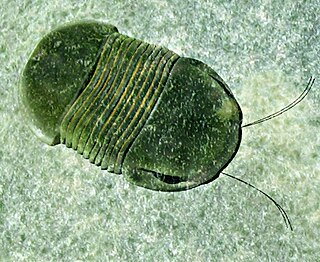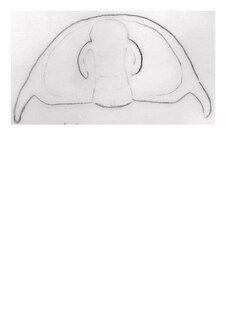
Agnostida is an order of arthropod which first developed near the end of the Early Cambrian period and thrived during the Middle Cambrian. They are present in the Lower Cambrian fossil record along with trilobites from the Redlichiida, Corynexochida, and Ptychopariida orders. The last agnostids went extinct in the Late Ordovician.

Trilobites are a group of extinct marine arthropods that form the class Trilobita. Trilobites form one of the earliest-known groups of arthropods. The first appearance of trilobites in the fossil record defines the base of the Atdabanian stage of the Early Cambrian period, and they flourished throughout the lower Paleozoic before slipping into a long decline, when, during the Devonian, all trilobite orders except the Proetida died out. The last extant trilobites finally disappeared in the mass extinction at the end of the Permian about 252 million years ago. Trilobites were among the most successful of all early animals, existing in oceans for almost 270 million years, with over 20,000 species having been described.

Honey ants, also called honeypot ants, are ants which have specialised workers that are gorged with food to the point that their abdomens swell enormously. Other ants then extract nourishment from them, through the process of trophallaxis. They function as living larders. Honeypot ants belong to any of several genera, including Myrmecocystus and Camponotus. They were first documented in 1881 by Henry C. McCook, and described further in 1908 by William Morton Wheeler.

Nektaspida is an extinct order of soft-bodied arthropods proposed by Raymond in 1920; its taxonomic status is uncertain. Specimens are known from the early Cambrian to the upper Silurian periods. A Russian find in the Vendian of the White Sea (=Ediacaran), Keretsia, has in 2006 also been attributed to this order, which would make it the earliest arthropod found yet. Whittington (1985) placed the order in the Trilobita. Cotton & Braddy (2000) place it in a new "Trilobite clade" containing the Trilobita, recognizing the close affinities of the nektaspids to trilobites. However this necessitates the inclusion of genera that look very little like trilobites., it was formerly placed in the stem-group to the chelicerata subdivision of the Arthropoda phylum. However, it currently considered part of Artiopoda, the clade that contains trilobites and their close relatives.

Asaphida is a large, morphologically diverse order of trilobites found in marine strata dated from the Middle Cambrian until their extinction during the Silurian. Asaphida contains six superfamilies, but no suborders. Asaphids comprise some 20% of described fossil trilobites.

Phacops is a genus of trilobites in the order Phacopida, family Phacopidae, that lived in Europe, northwestern Africa, North and South America and China from the Late Ordovician until the very end of the Devonian, with a broader time range described from the Late Ordovician. It was a rounded animal, with a globose head and large eyes, and probably fed on detritus. Phacops is often found rolled up ("volvation"), a biological defense mechanism that is widespread among smaller trilobites but further perfected in this genus.

Arachnomorpha is a subdivision or clade of Arthropoda, comprising the monophyletic group formed by the trilobites, other great appendage arthropods and trilobite-like families, and a diverse sister clade including the chelicerates. Great debate is held on the position of the Pycnogonida, which are currently thought not to be placed in the immediate vicinity of the Chelicerata. Arachnomorpha are considered the sister group to the crustaceans, which are increasingly being accepted as members of the mandibulate clade.

Cheiruridae is a family of phacopid trilobites of the suborder Cheirurina. Its members, as with other members of the suborder, had distinctive pygidia modified into finger-like spines. They first appeared in the uppermost Cambrian, and persisted until the end of the Middle Devonian (Givetian). Currently about 657 species assigned to 99 genera are included.

Greenops is a mid-sized Devonian trilobite of the order Phacopida, subfamily Asteropyginae. They are mainly reported from the mid-Devonian Hamilton Group of upstate New York and southwestern Ontario. A similar-looking trilobite from Morocco is often mis-labelled Greenops. Greenops had schizocroidal eyes, large genal spines and short, sharp spines at the tip of each segment of the pygidium ("tail"). Greenops lived in warm, fairly deep water. In the Hamilton Group of New York, they are found with Eldredgeops, Dipleura and Bellacartwrightia, a trilobite that resembles Greenops but has much larger pygidial spines. In Ontario, they are found in the Widder Formation, which outcrops at Arkona, where they are, by far, the dominant trilobite.
Beecher's Trilobite Bed is a Konservat-Lagerstätte of Late Ordovician (Caradoc) age located within the Frankfort Shale in Cleveland's Glen, Oneida County, New York, USA. Only 3-4 centimeters thick, Beecher's Trilobite Bed has yielded numerous exceptionally preserved trilobites with the ventral anatomy and soft tissue intact, the soft tissue preserved by pyrite replacement. Pyritisation allows the use of X-rays to study fine detail of preserved soft body parts still within the host rock. Pyrite replacement of soft tissue is unusual in the fossil record; the only Lagerstätten thought to show such preservation were Beecher's Trilobite Bed, the Devonian Hunsrück Slates of Germany, and the Jurassic beds of La Voulte-sur-Rhône in France, although new locations are coming to light in New York state.
The Walcott–Rust quarry, in Herkimer County, New York, is an excellent example of an obrution Lagerstätte. Unique preservation of trilobite appendages resulted from early consolidation (cementation) of the surrounding rock, followed by spar filling of the interior cavity within the appendages. The presence of so many well preserved trilobites in one location alone qualifies the beds as an exceptional trilobite site, but the beds are further distinguished as the source of the first trilobites for which appendages were definitively described.
Trilobites are used as index fossils to subdivide the Cambrian period. Assemblages of trilobites define trilobite zones. The Olenellus-zone has traditionally marked the top of the Lower Cambrian, and is followed by the Eokochaspis zone.
The cephalon is the head section of an arthropod. It is a tagma, i.e., a specialized grouping of arthropod segments. The word cephalon derives from the Greek κεφαλή (kephalē), meaning "head".

Bumastus is an extinct genus of corynexochid trilobites which existed from the Early Ordovician period to the Late Silurian period. They were relatively large trilobites, reaching a length of 6 in (15 cm). They were distinctive for their highly globular, smooth-surfaced exoskeleton. They possessed well-developed, large compound eyes and were believed to have dwelled in shallow-water sediments in life.

Eopeachella is an extinct genus of trilobites, fossil marine arthropods, with species of probably small size, entire, articulate specimens have not yet been found. It lived during the Toyonian stage, in what is today the South-Western United States. Eopeachella angustispina is the only known species in this genus.
Erromenosteus is a genus of extinct, medium-sized brachythoracid arthrodire placoderm from the Late Frasnian of the Kellwasserkalk facies of Late Devonian Bad Wildungen and Bicken, Germany.
Paranephrolenellus is an extinct genus of trilobite, fossil marine arthropods. Currently four species are attributed to it. Paranephrolenellus lived at the end of the Lower Cambrian.

Paleontology in Wisconsin refers to paleontological research occurring within or conducted by people from the U.S. state of Wisconsin. The state has fossils from the Precambrian, much of the Paleozoic, and the later part of the Cenozoic. Most of the Paleozoic rocks are marine in origin. Because of the thick blanket of Pleistocene glacial sediment that covers the rock strata in most of the state, Wisconsin’s fossil record is relatively sparse. In spite of this, certain Wisconsin paleontological occurrences provide exceptional insights concerning the history and diversity of life on Earth.
Cistus inflatus is a shrubby species of flowering plant in the family Cistaceae, often known as Cistus psilosepalus, although this name is a synonym of the hybrid Cistus × laxus. It has white flowers.

Calamphoreus inflatus is the only species of the flowering plant genus Calamphoreus in the family Scrophulariaceae. It is a shrub, formerly known as Eremophila inflata but unlike eremophilas, this species has twisted stamens and an urn-shaped petal tube which remains attached to the fruits after flowering.












